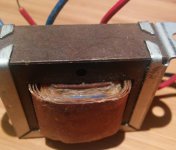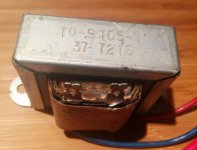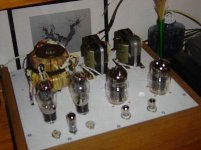One of the biggest problems in amplifier building is good layout which is best learned by copying what other people with lots of experience have built. If I were you, I would consider copying the Vinyl Savor design of one of his 6CB5A amps. The basic design is relatively simple and produces 7 -8 watts. He also shows lots of photos of the construction process that you can follow.
VinylSavor: Low Cost Single Ended 6CB5A Amplifier - Part 1
You could substitute Edcor or other transformers for the Lundahl at lower cost. However, remember to include the shipping costs when making your decision. The tubes he uses are very inexpensive and the amps apparently sound good.
Since the 6CB5A uses a top cap, you might want to think about the safety of those who live in your environment, particularly children and pets.
ray
VinylSavor: Low Cost Single Ended 6CB5A Amplifier - Part 1
You could substitute Edcor or other transformers for the Lundahl at lower cost. However, remember to include the shipping costs when making your decision. The tubes he uses are very inexpensive and the amps apparently sound good.
Since the 6CB5A uses a top cap, you might want to think about the safety of those who live in your environment, particularly children and pets.
ray
Opinions are divided on the subject of negative feedback.
Since this is a first time builder, I think the most important thing is to actually build an amplifier that works. Hopefully it will sound decent and work with his speakers. If they are Magnepan speakers as his moniker suggests, then the 6CB5A amp would probably not be suitable. I suspect most SE tubes amps would have problems driving those speakers.
It would be helpful if the original poster stated what speakers he plans to use and room size, music preference etc.
ray
Since this is a first time builder, I think the most important thing is to actually build an amplifier that works. Hopefully it will sound decent and work with his speakers. If they are Magnepan speakers as his moniker suggests, then the 6CB5A amp would probably not be suitable. I suspect most SE tubes amps would have problems driving those speakers.
It would be helpful if the original poster stated what speakers he plans to use and room size, music preference etc.
ray
My current favourite amplifier uses 10$ output transformers. The amp is a RH84. Power output is 5 Watt or something. Most expensive part is the power transformer 50 euro's.
Some old surplus paper bobbin I got from triodeelectronics yeaaars ago...But I'm sure most old 5k console output transformers (2nd hand) can be had for that price and make for lovely single ended EL84 amps.What is the $10 output transformer?
Roughly $5k for two OPTs, plus shipping from Belgium to US, customs duties, etc.
Given the current state of the Euro, however, you could get them about 20% cheaper now, though...
Thread: http://www.diyaudio.com/forums/tubes-valves/232484-midlife-crisis-my-833c-amp-build.html
PS: These sound fantastic with the very inefficient acoustic suspension Infinity RSIIb's in the picture. This is a bit of a special case, however.
Hi Magz, Great job with those amps!!!! I love the look of the 833C glowing like that🙂 My back is killing me just looking at them😉 I would like to make a guitar amp with a 833C, but lugging it around wouldn't be fun.
Hi Magz, Great job with those amps!!!! I love the look of the 833C glowing like that🙂 My back is killing me just looking at them😉 I would like to make a guitar amp with a 833C, but lugging it around wouldn't be fun.
If you're ever in the NJ area (not too far from MA) drop me a line. Maybe you can stop by and take a listen.
If you're ever in the NJ area (not too far from MA) drop me a line. Maybe you can stop by and take a listen.
Yes!! That would be incredible to hear them in the flesh!!
I did Vegas last year, but the previous 3 years I did Halloween in Atlantic City......good times.......Boardwalk Hall is a cool venue😎 Heck, I will drive down just for a couple of White House Italian subs and to listen to those monsters🙂
Cheers

My current favourite amplifier uses 10$ output transformers..
🙂 Bravo Bas

Member
Joined 2009
Paid Member
I agree with the other comments - an SE amplifier doesn't need to be exotic to sound good.
My first tube amp was very simple, no exotic parts. It's been so good I've yet to build another tube amp although I admit to having a 2A3 in my parts cupboard...
http://www.diyaudio.com/forums/tubes-valves/167872-my-cellini-triode-amp.html
My first tube amp was very simple, no exotic parts. It's been so good I've yet to build another tube amp although I admit to having a 2A3 in my parts cupboard...
http://www.diyaudio.com/forums/tubes-valves/167872-my-cellini-triode-amp.html
Haha...thanks 🙂Bravo Bas
TO-9105-1. Probably made for a guitar amp but: Paper in wax and many layers...so quite some care has been taken to construct them.What is the $10 output transformer?
This is what I could find about them:
TO-9105-1 5K/8 ohm Output Transformer
Primary 5,000 ohms, secondary 8 ohms, works fine with single 6BQ5/EL84 and 6V6-GT tubes. Mounting centers are 2 3/8 inch apart.NOS OEM surplus made by Ravenswood Electronics for "TMA Wheeling,Ill".
Attachments
Last edited:
Good job bas! I am using these super crappy tomiko's. I bought 6 of them for $150 (or maybe even less) a few years ago... My loftin-white design, 6SL7 driving 2a3 is my favourite amp now and uses these little disasters. They leak capacitance all over.. make stupid small noise just with the heaters on...I was about to pitch them about a dozen times... but in this circuit they simply shine. 🙂
The 6SL7's are actually russian 6n9s's - I splurged and spent $10 for a pair of them (including shipping). The 2a3's are the cheepest chinese ones that go for $20 each. But I actually got them free from a friend who was just going to throw them away.... I use $1 teevee damper diodes to rectify the mains...
This little amp is such a giant killer too. Its startlingly good and I love it. Took a while to design but I'm glad I built it now. The most expensive part is the Mains Transformer, which is top quality - I got it from Thomas Mayer. I highly highly highly recommend him. The second most expensive part is the Lundahl choke, which I also sourced from Thomas.
The sockets are re-cyled. The wire is whatever used stuff I had on hand. After listening to it breadboarded for a week, I just stuffed it into an old chassis I had from a previous project. The volume control cost a whopping $5.
I always thought it was the parts that made the amp. Not true. Its the circuit! Getting the circuit right is the MOST important thing to do.
No amount of simulation can substitute for actually building it and listening to it either. So if all you do is simulate stuff in Spice, then tooo BAD for you! 😉
Maybe I could take it with me on one of my many trips to the Netherlands so you can hear it. Its not that heavy It could fit in my checked luggage for sure.
I have to start a thread on it and share some pictures of it soon.
Ian
The 6SL7's are actually russian 6n9s's - I splurged and spent $10 for a pair of them (including shipping). The 2a3's are the cheepest chinese ones that go for $20 each. But I actually got them free from a friend who was just going to throw them away.... I use $1 teevee damper diodes to rectify the mains...
This little amp is such a giant killer too. Its startlingly good and I love it. Took a while to design but I'm glad I built it now. The most expensive part is the Mains Transformer, which is top quality - I got it from Thomas Mayer. I highly highly highly recommend him. The second most expensive part is the Lundahl choke, which I also sourced from Thomas.
The sockets are re-cyled. The wire is whatever used stuff I had on hand. After listening to it breadboarded for a week, I just stuffed it into an old chassis I had from a previous project. The volume control cost a whopping $5.
I always thought it was the parts that made the amp. Not true. Its the circuit! Getting the circuit right is the MOST important thing to do.
No amount of simulation can substitute for actually building it and listening to it either. So if all you do is simulate stuff in Spice, then tooo BAD for you! 😉
Maybe I could take it with me on one of my many trips to the Netherlands so you can hear it. Its not that heavy It could fit in my checked luggage for sure.
I have to start a thread on it and share some pictures of it soon.
Ian
Attachments
Last edited:
If only more people had made this discovery! Half the threads on here could disappear, so people could spend less time argueing and more time listening to music.soulmerchant said:I always thought it was the parts that made the amp. Not true. Its the circuit! Getting the circuit right is the MOST important thing to do.
A good circuit cannot compensate for terrible output transformers. You cannot push the negative feedback too hard because of phase problems which can result in a oscillating amp. Ofc you need some equipment and knowledge to check the results 😉
Like I mentioned before, you need good output transformers too but don´t have to pay such a huge price because eg. some manufacturer claims that their transformers sound great because of the use of silver instead of copper etc..
A good amp needs to have some negative feedback too if you really want to listen to good music and not stuff like this : https://www.youtube.com/watch?v=KcHjAUhtSrk
Best regards,
Like I mentioned before, you need good output transformers too but don´t have to pay such a huge price because eg. some manufacturer claims that their transformers sound great because of the use of silver instead of copper etc..
A good amp needs to have some negative feedback too if you really want to listen to good music and not stuff like this : https://www.youtube.com/watch?v=KcHjAUhtSrk
Best regards,
Components are just as important as the circuit, they are all links in the same chain.I always thought it was the parts that made the amp. Not true. Its the circuit! Getting the circuit right is the MOST important thing to do.
With clever circuits you can mask some shortcomings of cheaper components, but not all (i.e. not pushing an OPT beyond its capability).
I suggest, it is not the cost of a component that dictates it is quality.
A wise DIY'er should choose according to quality/per dollar/per final-result.
not just throw silly money on things.
Some guys simply copy some projects they find on the internet: They buy the most expensive output transformers, throw in a load of interstage transformers, use snake oil components like eg. magic capacitors or silver wire 😀 They may have spent a lot of cash in total but the result might still be bad in comparison to "cheaper" devices with a good circuit and good industry components ( eg. Wima Capacitors ). 😉
Best regards,
Best regards,
Quite unnecessarily Most expensive parts in tube amps is OPTs.
Let's see. I have own wound OPT for 6C33 SET amp, 9 layers:
- Vacumschmelze SM102-b double C cores with 0.1 mm lamination (from a local second hand store),
- 2 or 3 kgr (forget exactly) CuLL wire (from a local store)
- Teflon insulation between windings (5-6 unwind russian teflon capacitors 56nF/K72) + additional paper insulation between layers.
- Bobin done with material for PCB.
You can see my OPTs in atach. Sorry for the bad picture, it is very old.
Price for this top material was about 50 euros.
What do you think, how much $$$$$$ "brand X" producer asking for OPTs with such top material.
That is the biggest problem, as well as with cables and capacitors. And some tubes also.
Let's see. I have own wound OPT for 6C33 SET amp, 9 layers:
- Vacumschmelze SM102-b double C cores with 0.1 mm lamination (from a local second hand store),
- 2 or 3 kgr (forget exactly) CuLL wire (from a local store)
- Teflon insulation between windings (5-6 unwind russian teflon capacitors 56nF/K72) + additional paper insulation between layers.
- Bobin done with material for PCB.
You can see my OPTs in atach. Sorry for the bad picture, it is very old.
Price for this top material was about 50 euros.
What do you think, how much $$$$$$ "brand X" producer asking for OPTs with such top material.
That is the biggest problem, as well as with cables and capacitors. And some tubes also.
Attachments
My current favourite amplifier uses 10$ output transformers. The amp is a RH84. Power output is 5 Watt or something. Most expensive part is the power transformer 50 euro's.
😀 yes I like the RH84, however I'm using the EF86 driver..and edcor Op Tx's. Oh no silver input and selector wiring..and magic caps..😀
😱 there is even a Tantalum resistor on the input..Teflon wire eek..
XSE 15-8-5K
Ah well..🙄
Yes I wish I had managed to find some paper insulated output Tx's..different but subtle..
Regards
M. Gregg
Last edited:
- Status
- Not open for further replies.
- Home
- Amplifiers
- Tubes / Valves
- Most expensive parts in DIY tube amp




